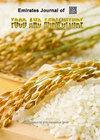利用基于稳定性的 AMMI 和 BLUP 方法获得高锌水稻的遗传增益并筛选出稳定的基因型
IF 0.7
4区 农林科学
Q3 AGRONOMY
引用次数: 0
摘要
水稻是全球近一半人口的主食,对儿童、孕妇和哺乳期妇女的营养影响尤为明显。由于性状是定量遗传的,因此会受到地点和年份变化的影响。研究人员采用三次重复的 RBD 方法,在印度北方邦鉴别出优良稳定的高锌水稻基因型。通过遗传关联研究发现,谷粒锌含量(GZC)与谷粒产量呈负相关。根据 AMMI 模型和双平面图,GYP 的 V16 和 V21 以及 GZC 的 V9、V2 和 V10 被确定为稳定的基因型。发现单株谷物产量(GYP)的 V11、V5 和 V21 以及 GZC 的 V14 和 V10 在所有 AMMI 稳定性参数中都是稳定和常见的。根据平均值与 WAASB 的双平面图,GYP 的 V6、V13 和 V5 以及 GZC 的 V10、V8 和 V2 被确定为稳定。根据 WAASBY 评分,GYP 的 V21 和 GZC 的 V4 产量最高,适应性广。用于 GYP 的 V13 和用于 GZC 的 V1 是历来的赢家。根据 BLUP,V13 和 V1 分别是 GYP 和 GZC 的最高预测平均值。根据多性状稳定指数(MTSI),V6、V21 和 V13 被确定为稳定型并被选中。这些通过基于BLUP的稳定性方法、MTSI和强弱图谱筛选出的基因型更易于为品种推荐和未来的锌强化水稻育种研究评估和选择基因型。 关键词GEI,高锌水稻,MTSI,稳定基因型本文章由计算机程序翻译,如有差异,请以英文原文为准。
Genetic gain and selection of stable genotypes in high zinc rice using AMMI and BLUP based stability methods
Rice is the staple food of almost half of the world’s population, impacting nutrition especially in children, pregnant women, and nursing mothers. Because the traits were quantitatively inherited, they are affected by changes in location and year. A RBD with three replications was used to identify superior and stable high-zinc rice genotypes in Uttar Pradesh, India. Grain zinc content (GZC) is negatively correlated with grain yield using genetic association study. There was a significant G × E interaction (GEI) and V16 and V21 for GYP and V9, V2 and V10 for GZC were identified as stable based on the AMMI model and bi-plot. V11, V5, V21 for grain yield per plant (GYP) and for GZC, V14, and V10 are found to be stable and common in all AMMI stability parameters. V6, V13 and V5 for GYP and V10, V8 and V2 for GZC were identified as stable based on the mean vs. WAASB bi-plot. V21 for GYP and V4 for GZC was the highest yielder and widely adaptable based on WAASBY scores. V13 for GYP and V1 for GZC were all-time winners. V13 and V1 have the highest predicted mean for GYP and GZC, respectively, based on BLUP. V6, V21and V13 were identified as stable and selected based on the multi-trait stability index (MTSI). These selected genotypes selected through BLUP-based stability methods, MTSI, and strength and weakness plots make it easier to evaluate and select genotypes for varietal recommendations and future Zn-fortified rice breeding studies. Keywords: GEI, High Zinc Rice, MTSI, Stable genotype
求助全文
通过发布文献求助,成功后即可免费获取论文全文。
去求助
来源期刊

Emirates Journal of Food and Agriculture
AGRONOMYFOOD SCIENCE & TECHNOLOGY&nb-FOOD SCIENCE & TECHNOLOGY
CiteScore
1.80
自引率
0.00%
发文量
18
期刊介绍:
The "Emirates Journal of Food and Agriculture [EJFA]" is a unique, peer-reviewed Journal of Food and Agriculture publishing basic and applied research articles in the field of agricultural and food sciences by the College of Food and Agriculture, United Arab Emirates University, United Arab Emirates.
 求助内容:
求助内容: 应助结果提醒方式:
应助结果提醒方式:


